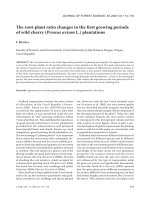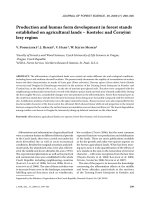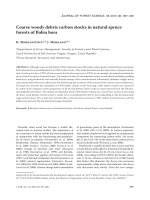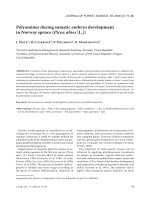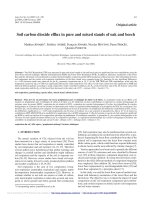Báo cáo lâm nghiệp: " Factors modulating superoxide dismutase activity in needles of spruce trees (Picea abies L.)" doc
Bạn đang xem bản rút gọn của tài liệu. Xem và tải ngay bản đầy đủ của tài liệu tại đây (156.1 KB, 4 trang )
Factors
modulating
superoxide
dismutase
activity
in
needles
of
spruce
trees
(Picea
abies
L.)
A. Polle’
B. Krings
2
H.
Rennenberg
1
1
Fraunhofer /nstitut für Atm.
Umweltforschung,
Kreuzeckbahnstr.
19,
D-8100
Garmisch-Partenkir-
chen, and
2
Botanisches
Institut der
Universitat zu
Koln,
Gyrhofstr.
15,
D-5000
Kbin
41,
F.R.G.
Introduction
Superoxide
dismutases
(SOD)
are
consid-
ered
to
be
a
major
enzymic
defense
against
oxygen
toxicity
in
cells
(Fridovich,
1986).
These
enzymes
contain
either
Cu/Zn,
Mn
or
Fe
in
their
catalytic
center
(Fridovich,
1986).
Most
abundant
in
plants
are
Cu/Zn-SODs
which
are
characterized
by
a
broad
pH-optimum
between
pH
7
and
pH
10
and
an
inhibition
by
cyanide
and
H202
(Fridovich,
1986).
SODs
detoxify
superoxide
radicals
originating
from
phy-
siological
functions,
such
as
photosynthe-
sis
under
excess
light
energy
(Robinson,
1988),
as
well
as
different
environmental
stress
factors,
such
as
herbicides
and
air
pollutants
(0
3,
S0
2,
N0
2)
(Rabinowitch
and
Fridovich,
1983;
Fridovich,
1986).
Since
it
is
generally
assumed
that
air
pollu-
tion
is
one
of
the
major
reasons
for
forest
decline
in
Central
Europe,
we
compared
SOD
activity
in
needles
of
healthy
and
in-
jured
spruce
trees
growing
in
the
field.
Materials
and
Methods
Experiments
were
performed
with
needles
from
Norway
spruce
trees
(Picea
abies
L.)
growing
in
the
field.
Extracts
of
spruce
needles
were
pre-
pared
as
described
elsewhere
(Polle
et
al.,
1989).
After
dialysis,
the
activity
of
superoxide
dismutase
was
determined
according
to
the
method
of
Misra
and
Fridovich
(1972).
This
assay
is
based
on
the
autooxidation
of
epine-
phrine
to
adrenochrome
at
pH
10.2.
0!
serves
as
the
chain-propagating
species
in
this
reac-
tion.
SOD
competes
for
02,
thus
inhibiting
adrenochrome
formation.
By
definition,
1
unit
of
SOD
is
the
amount
of
extract
that
inhibits
the
maximal
rate
of
adrenochrome
formation
by
50%.
Results
To
determine
SOD
activity,
we
adapted
extraction
and
assaying
procedures
(after
Misra
and
Fridovich,
1972)
to
extracts
from
spruce
needles
(Polle
et
al.,
1989).
Fig.
1
shows
a
typical
calibration
curve
for
spruce
SOD.
Increasing
amounts
of
spruce
extract
exhibited
increasing
inhibi-
tion
of
adrenochrome
formation
with
a
saturation
level
of
80%.
In
comparison
with
spruce
extract,
a
commercially
avail-
able
SOD
preparation
from
horseradish
reached
a
saturation
level
of
90%
in
this
assay
system
(not
shown).
The
failure
to
obtain
complete
inhibition
was
attributed
to
alternative
oxidative
pathways
(Misra
and
Fridovich,
1972;
Fridovich,
1986).
possibly
caused
by
interactions
with
other
components
present
in
crude
dialyzed
spruce
extracts.
In
the
presence
of
cyanide
(20
pM
NaCN),
the
inhibition
of
adrenochrome
for-
mation
was
completely
blocked
(not
shown).
This
observation
indicates
that
predominately
Cu/Zn-containing
SOD-
species
contributed
to
the
activity
deter-
mined
with
the
epinephrine
assay.
It
has
been
reported
for
other
plants
that
the
activity
of
SOD
is
dependent
upon
the
developmental
stage
of
the
tissue
ana-
lyzed
(Rabinowitch
and
Fridovich,
1983).
However,
data
on
developmentally
deter-
mined
changes
in
SOD
activity
in
needles
of
conifers
have
not
been
published.
Therefore,
the
activity
of
SOD
was
analyz-
ed
in
4
subsequent
generations
of
needles
of
healthy
trees
and
compared
with
the
activity
in
needles
of
injured
trees
with
50%
loss
of
needles.
In
needles
from
healthy
trees,
SOD
ac-
tivity
was
highest
in
the
youngest
needles
and
then
declined
by
about
25%
in
4
yr
old
needles.
In
needles
from
injured
trees,
an
enhanced
level
of
SOD
activity
was
maintained
through
the
4
needle
genera-
tions
studied.
Discussion
Enhanced
activity
of
superoxide
dismu-
tase
in
younger
leaves
has
previously
been
reported
in
several
plant
species
(Rabinowitch
a.nd
Fridovich,
1983)
and
was
accompanied
by
an
enhanced
toler-
ance
against
SO
(Tanaka
and
Sugahara,
1980).
Furthermore,
higher
SOD
activities
were
found
in
conifer
needles
after
ozone
fumigation
(Castillo
et
al.,
1987)
or
if
the
trees
were
growing
in
S0
2
-polluted
regions
(Huttunen
and
Heiska,
1988).
We
observed
in
healthy
needles
of
spruce
trees
growing
in
the
field
that
SOD
activity
showed
a
maximum
in
the
youngest
needles
and
then
declined.
In
young
needles
of
severely
injured
trees,
the
SOD
activity
was
slightly
enhanced
as
com-
pared
to
SOD
activity
in
needles
from
healthy
trees.
This
high
level
of
SOD
activity
was
maintained
in
the
4
needle
generations
analyzed.
This
result
sug-
gests,
that
among
other
factors,
SOD
ac-
tivity
in
young
needles
is
determined
by
intrinsic
developmental
factors,
while
in
older
needles,
external
environmental
trig-
gering
mechanisms,
such
as,
perhaps,
air
pollution,
play a
major
role
in
the
regula-
tion
of
SOD
activity.
Acknowledgments
We
thank
Beate
Huber
and
Monika
Braun
for
expert
technical
assistance
and
acknowledge
financial
support
from
the
Bundesminister
fur
Forschung
und
Technologie
under
contract
no.
0339019B7.
References
Castillo
F.J.,
Miller
P.R.
&
Greppin
H.
(1987)
Waldsterben
Part
IV.
Extracellular
biochemical
markers
of
photochemical
oxidant
air
pollution
damage
to
Norway
spruce.
Experientia
43, 111-
115
5
Fridovich
1.
(1986)
Superoxide
dismutases.
Adv.
Enzymol.
58, 61-97
Huttunen
S.
&
Heiska
E.
(1988)
Superoxide
dis-
mutase
activity
in
Scots
pine
(Pinus
sylvestris
L.)
and
Norway
spruce
(Picea
abies
L.)
needles
in
northern
Finland.
Eur.
J.
For.
Pathol.
18,
343-
350
Misra
H.P.
&
Fridovich
1.
(1972)
The
role
of
superoxide
anion
in
the autooxidation
of
epine-
phrine
and
a
simple
assay
for
superoxide
dis-
mutase.
J.
BioL
Cibem.
247,
3170-3175
Polle
A.,
Krings
B.
&
Rennenberg
H.
(1989)
Superoxide
dismutase
activity
in
needles
of
Norwegian
spruce;
trees
(Picea
abies
L.).
Plant
Physiol.
90, 1310-1316
6
Rabinowitch
H.D.
&
Fridovich
1.
(1983)
Super-
oxide
radicals,
superoxide
dismutases
and
oxy-
gen
toxicity
in
plants.
Photochem.
Photobiol.
37, 679-690
Robinson
J.M.
(1988)
Does
02
photoreduction
occur
within
chloroplasts
in
vivo?
Physiol.
Plant.
72,
666-680
Tanaka
K.
&
Sugahara
K.
(1980)
Role
of
super-
oxide
dismutase
in
defense
against
S0
2
toxicity
and
an
increase
in
superoxide
dismutase
activi-
ty
with
S0
2
fumigation.
Plant
Cell
Physiol.
21,
601-611
